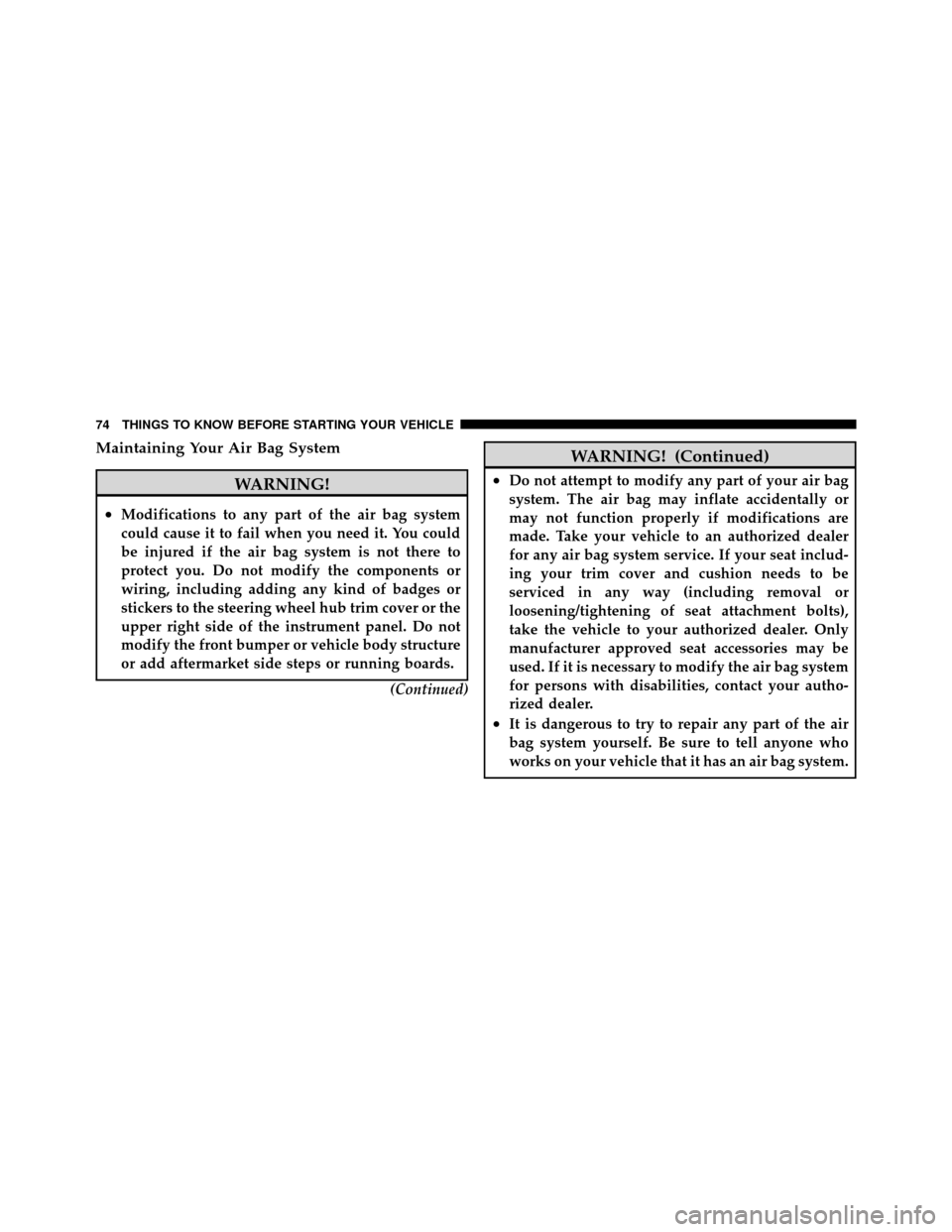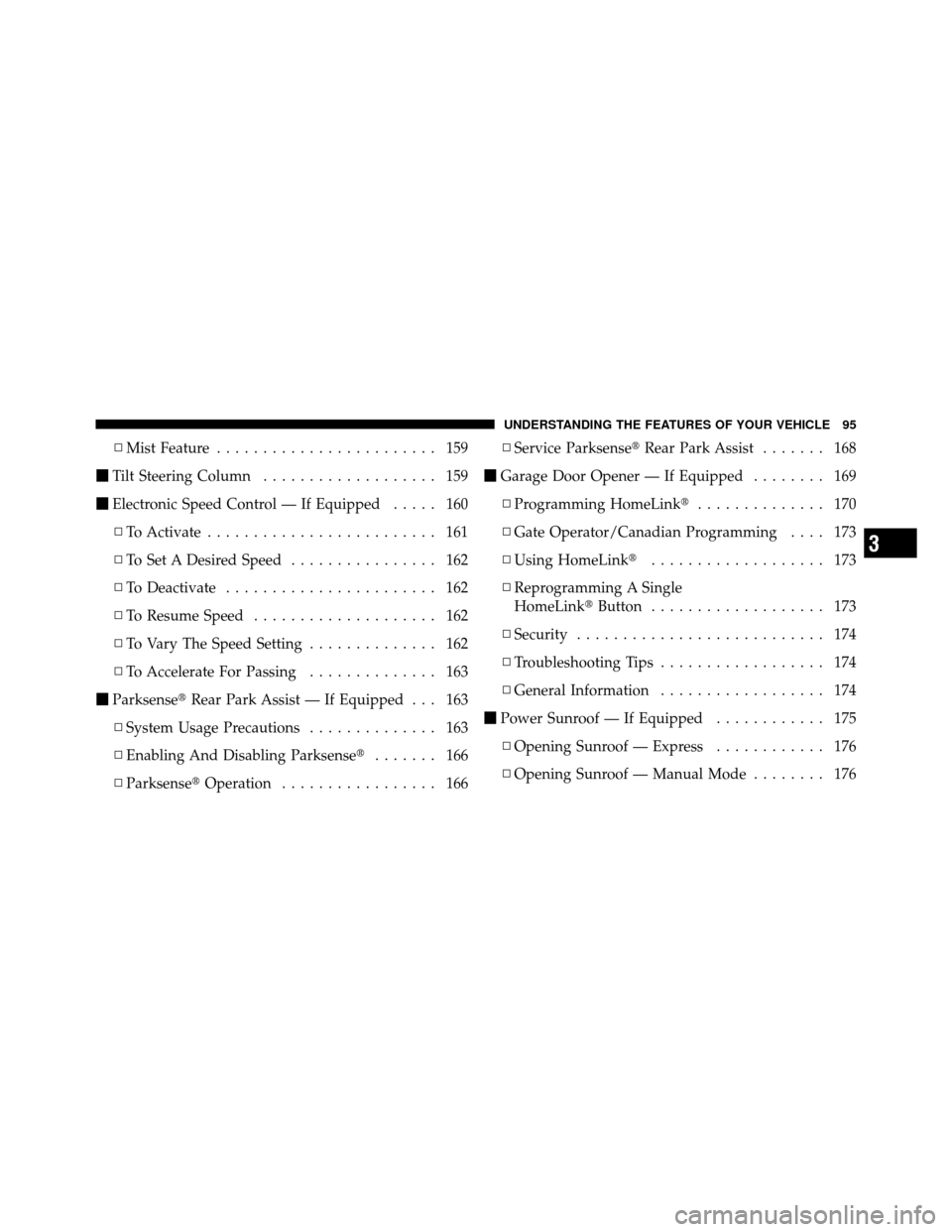Page 42 of 497
WARNING!
Driving with the liftgate open can allow poisonous
exhaust gases into your vehicle. You and your pas-
sengers could be injured by these fumes. Keep the
liftgate closed when you are operating the vehicle.
OCCUPANT RESTRAINTS
Some of the most important safety features in your
vehicle are the restraint systems:
•Three-point lap and shoulder belts for all seating
positions
•Advanced Front Air Bags for driver and front passen-
ger
•Supplemental Active Head Restraints (AHR) located
on top of the front seats (integrated into the head
restraint)
•Supplemental Side Air Bag Inflatable Curtains
(SABIC) for the driver and passengers seated next to a
window
•An energy-absorbing steering column and steering
wheel
•Knee bolsters/blockers for front seat occupants
Liftgate Release
2
THINGS TO KNOW BEFORE STARTING YOUR VEHICLE 39
Page 45 of 497

WARNING! (Continued)
•Being too close to the steering wheel or instrument
panel during Advanced Front Air Bag deployment
could cause serious injury, including death. Air
Bags need room to inflate. Sit back, comfortably
extending your arms to reach the steering wheel or
instrument panel.
•Supplemental Side Air Bag Inflatable Curtain
(SABIC) also need room to inflate. Do not lean
against the door or window. Sit upright in the
center of the seat.
•In an accident, you and your passengers can suffer
much greater injuries if you are not properly
buckled up. You can strike the interior of your
vehicle or other passengers, or you can be thrown
out of the vehicle. Always be sure you and others
in your vehicle are buckled up properly.Buckle up even though you are an excellent driver, even
on short trips. Someone on the road may be a poor driver
and cause an accident that includes you. This can happen
far away from home or on your own street.
Research has shown that seat belts save lives, and they
can reduce the seriousness of injuries in an accident.
Some of the worst injuries happen when people are
thrown from the vehicle. Seat belts reduce the possibility
of ejection and the risk of injury caused by striking the
inside of the vehicle. Everyone in a motor vehicle should
be belted at all times.
42 THINGS TO KNOW BEFORE STARTING YOUR VEHICLE
Page 61 of 497
Supplemental Restraint System (SRS) — Air Bags
This vehicle has Advanced Front Air Bags for both the
driver and front passenger as a supplement to the seat
belt restraint systems. The driver’s Advanced Front Air
Bag is mounted in the steering wheel. The passenger’s
Advanced Front Air Bag is mounted in the instrument
panel, above the glove compartment. The words SRS/
AIRBAG are embossed on the air bag covers.
NOTE:These air bags are certified to the new Federal
regulations for Advanced Air Bags.
The Advanced Front Air Bags have a multistage inflator
design. This allows the air bag to have different rates of
inflation that are based on the severity and type of
collision.
Advanced Front Air Bag And Knee Bolster Locations
1 — Driver And Passenger Advanced Front Air Bags
2 — Knee Bolster
58 THINGS TO KNOW BEFORE STARTING YOUR VEHICLE
Page 63 of 497

Air Bag System Components
Your vehicle may be equipped with the following air bag
system components:
•Occupant Restraint Controller (ORC)
•Air Bag Warning Light
•Steering Wheel and Column
•Instrument Panel
•Knee Impact Bolster
•Driver Advanced Front Air Bag
•Passenger Advanced Front Air Bag
•Supplemental Side Air Bag Inflatable Curtains
(SABIC)
•Front and Side Impact Sensors
•Front Seat Belt Pretensioners, Seat Belt Buckle Switch,
and Seat Track Position Sensors
•Supplemental Active Head Restraint for Driver and
Front Passenger
•Occupant Classification System (OCS)
•Occupant Classification Module (OCM)
•Passenger Air Bag Disable (PAD) Indicator Light
•Weight Sensors
Advanced Front Air Bag Features
The Advanced Front Air Bag system has multistage
driver and front passenger air bags. This system provides
output appropriate to the severity and type of collision as
determined by the Occupant Restraint Controller (ORC),
which may receive information from the front impact
sensors.
60 THINGS TO KNOW BEFORE STARTING YOUR VEHICLE
Page 72 of 497

If there is a fault present in the air bag system, the Air Bag
Warning Light (a red light located in the center of the
instrument cluster directly in front of the driver) will be
turned on. This indicates that you should have an autho-
rized dealer service the system immediately. The Air Bag
Warning Light is turned on whenever there is a fault that
can affect the operation of the air bag system. If there is a
fault present in the PAD Indicator Light, the Air Bag
Warning Light will be illuminated to show that the
passenger Advanced Front Air Bag may be turned off
until the fault is cleared. If the Air Bag Warning Light is
illuminated, have an authorized dealer service the air bag
system immediately. If an object is lodged under the seat
and interferes with operation of the weight sensors, a
fault will occur which turns on both the PAD Indicator
Light and the Air Bag Warning Light. Once the lodged
object is removed, the fault will be automatically cleared
after a short period of time.Driver And Passenger Advanced Front Air Bag
Inflator Units
TheDriver And Passenger Advanced Front Air Bag
Inflator Units are located in the center of the steering
wheel and on the right side of the instrument panel.
When the ORC detects a collision requiring the Ad-
vanced Front Air Bags, it signals the inflator units. A large
quantity of non-toxic gas is generated to inflate the
Advanced Front Air Bags. Different air bag inflation rates
are possible based on collision severity and type. The
steering wheel hub trim cover and the upper right side of
the instrument panel separate and fold out of the way as
the air bags inflate to their full size. The air bags fully
inflate in about 50 to 70 milliseconds. This is about half of
the time it takes to blink your eyes. The air bags then
quickly deflate while helping to restrain the driver and
front passenger.
2
THINGS TO KNOW BEFORE STARTING YOUR VEHICLE 69
Page 77 of 497

Maintaining Your Air Bag System
WARNING!
•Modifications to any part of the air bag system
could cause it to fail when you need it. You could
be injured if the air bag system is not there to
protect you. Do not modify the components or
wiring, including adding any kind of badges or
stickers to the steering wheel hub trim cover or the
upper right side of the instrument panel. Do not
modify the front bumper or vehicle body structure
or add aftermarket side steps or running boards.(Continued)
WARNING! (Continued)
•Do not attempt to modify any part of your air bag
system. The air bag may inflate accidentally or
may not function properly if modifications are
made. Take your vehicle to an authorized dealer
for any air bag system service. If your seat includ-
ing your trim cover and cushion needs to be
serviced in any way (including removal or
loosening/tightening of seat attachment bolts),
take the vehicle to your authorized dealer. Only
manufacturer approved seat accessories may be
used. If it is necessary to modify the air bag system
for persons with disabilities, contact your autho-
rized dealer.
•It is dangerous to try to repair any part of the air
bag system yourself. Be sure to tell anyone who
works on your vehicle that it has an air bag system.
74 THINGS TO KNOW BEFORE STARTING YOUR VEHICLE
Page 94 of 497
Periodic Safety Checks You Should Make Outside
The Vehicle
Tires
Examine tires for excessive tread wear and uneven wear
patterns. Check for stones, nails, glass, or other objects
lodged in the tread or sidewall. Inspect the tread for cuts
and cracks. Inspect sidewalls for cuts, cracks and bulges.
Check the wheel nuts for tightness. Check the tires
(including spare) for proper cold inflation pressure.
Lights
Have someone observe the operation of exterior lights
while you work the controls. Check turn signal and high
beam indicator lights on the instrument panel.
Door Latches
Check for positive closing, latching, and locking.
Fluid Leaks
Check area under vehicle after overnight parking for fuel,
engine coolant, oil, or other fluid leaks. Also, if gasoline
fumes are detected or if fuel, power steering fluid, or
brake fluid leaks are suspected, the cause should be
located and corrected immediately.2
THINGS TO KNOW BEFORE STARTING YOUR VEHICLE 91
Page 98 of 497

▫Mist Feature ........................ 159
� Tilt Steering Column ................... 159
� Electronic Speed Control — If Equipped ..... 160
▫ To Activate ......................... 161
▫ To Set A Desired Speed ................ 162
▫ To Deactivate ....................... 162
▫ To Resume Speed .................... 162
▫ To Vary The Speed Setting .............. 162
▫ To Accelerate For Passing .............. 163
� Parksense� Rear Park Assist — If Equipped . . . 163
▫ System Usage Precautions .............. 163
▫ Enabling And Disabling Parksense� ....... 166
▫ Parksense� Operation................. 166 ▫
Service Parksense� Rear Park Assist....... 168
� Garage Door Opener — If Equipped ........ 169
▫ Programming HomeLink� .............. 170
▫ Gate Operator/Canadian Programming .... 173
▫ Using HomeLink� ................... 173
▫ Reprogramming A Single
HomeLink� Button................... 173
▫ Security ........................... 174
▫ Troubleshooting Tips .................. 174
▫ General Information .................. 174
� Power Sunroof — If Equipped ............ 175
▫ Opening Sunroof — Express ............ 176
▫ Opening Sunroof — Manual Mode ........ 176
3
UNDERSTANDING THE FEATURES OF YOUR VEHICLE 95